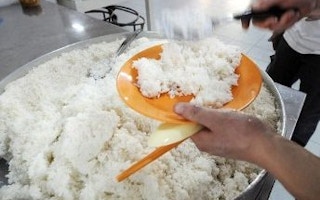A family of five cooks a kilogram of rice in a pot for breakfast. Somebody forgets about it and it burns—the rice at the bottom of the pot becomes almost inedible. The kids don’t finish their meals. Leftover rice is all over their plates and in the pot, which will sit in the kitchen for hours. At the end of the day, the family throws away a plastic bag full of burned and spoiled rice. This is how a family as well as many households and restaurants in the Philippines waste this high demand political commodity, which feeds half of the world’s population.
At first, this fact may not sit well with the Philippines’ annual per capita consumption of 120 kilograms, or about 5 cups, of rice per day. Why buy that much rice for the table when a significant amount is thrown away, taking with it all the nutrients and energy that rice can give? National Food Authority Administrator Angelito Banayo has a term for this behavior—takaw-tingin (literally, takaw pertains to gluttony, tingin means sight; the concept refers to impulse buying or acquiring at the sight of things desirable). But, what seems to be wrong with a few grains of rice left on the plate or in the pot? The devil is in the details.
Throwing it away
Research shows that the Philippines, the world’s biggest rice importer for several years, wastes rice that is worth at least US$535,000 (23 million pesos) every day, or at least $223 million a year—enough to feed 4.3 million people. The Food and Nutrition Research Institute (FNRI), under the Department of Science and Technology, revealed these 2008 data, further noting that every Filipino wastes an average of 3 tablespoons (9 grams) of rice daily, which is equivalent to 3.3 kilograms per year.
With 94 million people (National Statistics Office 2010) and 9 grams of wasted rice per day (FNRI 2008), the total wastage is 308,000 tons: 36 per cent of the 2011 rice imports.
Wasted grams per head actually vary in different regions across the Philippines. FNRI’s National Nutrition Survey shows that on one of the three island groups of the Philippines, Luzon, daily rice and product wastage is 16 grams per capita and 12 grams each for the other two, Visayas and Mindanao. Also, middle-class families tend to waste more than low-income families. Apparently, the more people have, the more they waste.
If the Philippine figures cause deep concern, global figures for “throwaways,” plus post harvest losses, can be alarming.
Chain of waste
A Food and Agriculture Organization (FAO) study, “2011 Global food losses and food waste,” revealed that a third of global food (1 billion tons) is wasted. Part of this is cereals (including rice). Losses in rice come from the unmilled grains through poor harvesting and post harvest activities, inefficient transportation, inadequate storage, wasteful processing, and market spoilage.
The first rice wastage happens after harvesting. Cited in the report, losses during agricultural production happen when rice grains spill and degrade during handling, storage, and transportation between the farm and distribution to markets (wholesale, retail, supermarket, and wet markets).
Consumption, when the final wastage takes place, usually results in throwaways (due to “bad cooking”) or leftovers. “Perhaps one of the most important reasons for food waste at the consumption level in rich countries,” explained the FAO report, “is that people simply can afford to waste food.”
How much food is lost and wasted in the world today and how can we prevent this? “These questions are impossible to answer precisely, and not much research is going on in this area,” lamented the report. With global population now more than 7 billion people and continuing to increase and food production having difficulty catching up, a lack of critical attention to this is surprising.
Preventing waste, saving lives
Will it be hard to change the wasteful eating habits in the Philippines? According to Flordeliza Bordey, an economist at the Philippine Rice Research Institute (PhilRice), “If we look at the trend of the two FNRI surveys (2003 and 2008), it is not impossible to influence the seemingly wasteful eating behavior of Filipinos.” Campaigns on raising awareness can be a key to this.
Dr. Bordey, who is also the program leader of PhilRice’s impact evaluation, policy research, and advocacy, said that PhilRice launched a rice awareness campaign in 2011, as part of its celebration of rice awareness month (November). “The messages of this campaign are ‘eat your rice right’ and ‘save rice, save lives,’ which advocated reducing rice waste at the consumer level,” she added. The activities included a fun run, university visits, and Facebook blogs.
According to Dr. Bordey, PhilRice proposes a similar campaign during the national year of rice in 2012. Approved by the Department of Agriculture, this campaign aims to reach out to more consumers.
The hundred tons of rice wasted each year, not just in the Philippines but in the whole world, need to be taken seriously. Our social conscience will tell us that the rice we waste (or money, for that matter) can just be the very rice we need to feed the hungry and the undernourished.
As research institutions take part in securing food for the next generations through high-yielding crops, consumers must also help solve problems in food scarcity through responsible consumption, so that everyone will have enough to eat.
This story by Aileen Macalintal was originally published on April 12 in Rice Today and has been republished with permission.











